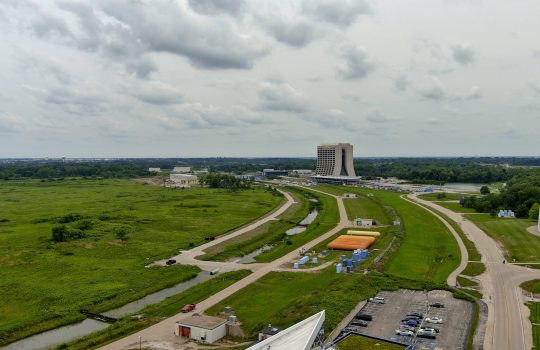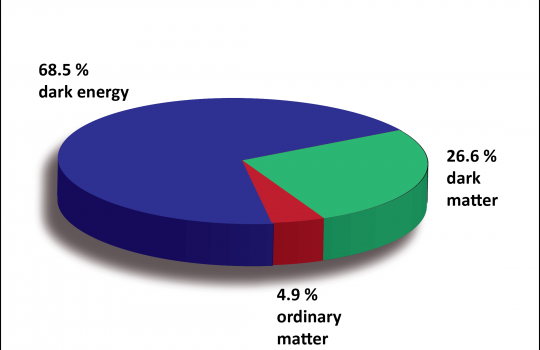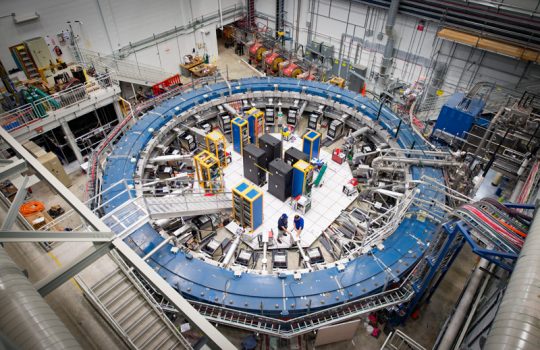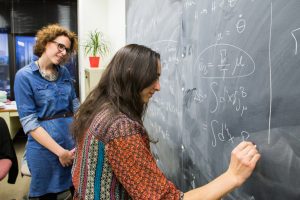
Pilar Coloma (left) and Seyda Ipek write calculations from floor to ceiling as they try to find solutions to lingering questions about our current models of the universe. Photo: Rashmi Shivni, OC
Some of the ideas you’ve probably had about theoretical physicists are true.
They toil away at complicated equations. The amount of time they spend on their computers rivals that of millennials on their hand-held devices. And almost nothing of what they turn up will ever be understood by most of us.
The statements are true, but as you might expect, the resulting portrait of ivory tower isolation misses the mark.
The theorist’s task is to explain why we see what we see and predict what we might expect to see, and such pronouncements can’t be made from the proverbial armchair. Theorists work with experimentalists, their counterparts in the proverbial field, as a vital part of the feedback loop of scientific investigation.
“Sometimes I bounce ideas off experimentalists and learn from what they have seen in their results,” said Fermilab theorist Pilar Coloma, who studies neutrino physics. “Or they may find something profound in theory models that they want to test. My job is all about pushing the knowledge forward so other people can use it.”
Predictive power
Theorists in particle physics — the Higgses and Hawkings of the world — push knowledge by making predictions about particle interactions. Starting from the framework known as the Standard Model, they calculate, say, the likelihood of numerous outcomes from the interaction of two electrons, like a blackjack player scanning through the possibilities for the dealer’s next draw.
Experimentalists can then seek out the predicted phenomena, rooting around in the data for a never-before-seen phenomenon.
Theorists’ predictions keep experimentalists from having to shoot in the dark. Like an experienced paleontologist, the theorist can tell the experimentalist where to dig to find something new.
“We simulate many fake events,” Coloma said. “The simulated data determines the prospects for an experiment or puts a bound on a new physics model.”
The Higgs boson provides one example. By 2011, a year before CERN’s ATLAS and CMS experiments announced they’d discovered the Higgs boson, theorists had put forth nearly 100 different proposals by as many different methods for the particle’s mass. Many of the predictions were indeed in the neighborhood of the mass as measured by the two experiments.
And like the paleontologist presented with a new artifact, the theorist also offers explanations for unexplained sightings in experimentalists’ data. She might compare the particle signatures in the detector against her many fake events. Or given an intriguing measurement, she might fold it into the next iteration of calculations. If experimentalists see a particle made of a quark combination not yet on the books, theorists would respond by explaining the underlying mechanism or, if there isn’t one yet, work it out.
“Experimentalists give you information. ‘We think this particle is of this type. Do you know of any Standard Model particle that fits?’” said Seyda Ipek, a theorist studying the matter-antimatter imbalance in the universe. “At first it might not be obvious, because when you add something new, you change the other observations you know are in the Standard Model, and that puts a constraint on your models.”
And since the grand aim of particle physics theory is to be able to explain all of nature, the calculation developed to explain a new phenomenon must be extendible to a general principle.
“Unless you have a very good prediction from theory, you can’t convert that experimental measurement into a parameter that appears in the underlying theory of the Standard Model,” said Fermilab theorist John Campbell, who works on precision theoretical predictions for the ATLAS and CMS experiments at the Large Hadron Collider.
Calculating moves
The theorist’s calculation starts with the prospect of a new measurement or a hole in a theory.
“You look at the interesting things that an experiment is going to measure or that you have a chance of measuring,” Campbell said. “If the data agrees with theory everywhere, there’s not much room for new physics. So you look for small deviations that might be a sign of something. You’re really trying to dream up a new set of interactions that might explain why the data doesn’t agree somewhere.”
In its raw form, particle physics data is the amount and location of the energy a particle deposits in a particle detector. The more sensitive the detector, the more accurate the experimentalists’ measurement, and the more precise the corresponding calculation needs to be.
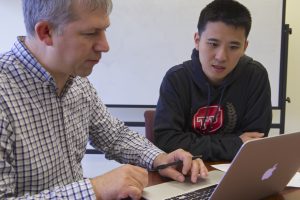
Fermilab theorists John Campbell (left) and Ye Li work on a calculation that describes the interactions you might expect to see in the complicated environment of the LHC. Photo: Rashmi Shivni
The CMS detector at the Large Hadron Collider, for example, allows scientists to measure some probabilities of particle interactions to within a few percent. And that’s after taking into account that it takes one million or even one billion proton-proton collisions to produce just one interesting interaction that CMS would like to measure.
“When you’re making the measurement that accurately, it demands a prediction at a very high level,” Campbell said. “If you’re looking for something unexpected, then you need to know the expected part in quite a lot of detail.”
A paleontologist recognizes the vertebra of a brachiosaurus, and the theoretical particle physicist knows what the production of a pair of top quarks looks like in the detector. A departure from the known picture triggers him to take action.
“So then you embark on this calculation,” Campbell said.
Embark, indeed. These calculations are not pencil-and-paper assignments. A single calculation predicting the details of a particle interaction, for example, can be a prodigious effort that takes months or years.
So-called loop corrections are one example: Theorists home in on what happens during a particle event by adding detail — a correction — to an approximate picture.
Consider two electrons that approach each other, exchange a photon and diverge. Zooming in further, you predict that the photon emits and reabsorbs yet another pair of particles before it itself is reabsorbed by the electron pair. And perhaps you predict that, at the same time, one of the electrons emits and reabsorbs another photon all on its own.
Each additional quantum-scale effect, or loop, in the big-picture interaction is like pennies on the dollar, changing the accounting of the total transaction — the precision of a particle mass calculation or of the interaction strength between two particles.
With each additional loop, the task of performing the calculation becomes that much more formidable. (“Loop” reflects how the effects are represented pictorially in Feynman diagrams — details in the approximate picture of the interaction.) Theorists were computing one-loop corrections for the production of a Higgs boson arising from two protons until 1991. It took another 10 years to complete the two-loop corrections for the process. And it wasn’t until this year, 2016, that they finished computing the three-loop corrections. Precise measurements at the Large Hadron Collider would (and do) require precise predictions to determine the kind of Higgs boson that scientists would see, demanding the decades-long investment.
“Doing these calculations is not straightforward, or we would have done them a long time ago,” Campbell said.
Once the theorist completes a calculation, they might publish a paper or otherwise make their code broadly available. From there, experimentalists can use the code to simulate how it will look in the detector. Farms of computers map out millions of fake events that take into account the new predictions provided courtesy of the theorist.
“Without a network of computers available, our studies can’t be done in a reasonable time,” Coloma said. “A single computer can not analyze millions of data points, just as a human being could never take on such a task.”
If the simulation shows that, for example, a particle might decay in more ways than what the experiment has seen, the theorist could suggest that experimentalists expand their search.
“We’ve pushed experiments to look in different channels,” Ipek said. “They could look into decays of particles into two-body states, but why not also 10-body states?”
Theorists also work with an experiment, or multiple experiments, to put their calculations to best use. Armed with code, experimentalists can change a parameter or two to guide them in their search for new physics. What happens, for example, if the Higgs boson interacts a little more strongly with the top quark than we expect? How would that change what we see in our detectors?
“That’s a question they can ask and then answer,” Campbell said. “Anyone can come up with a new theory. It is best to try to provide a concrete plan that they can follow.”
Outlandish theories and concrete plans
Concrete plans ensure a fruitful relationship between experiment and theory. The wilder, unconventional theories scientists dream up take the field into exciting, uncharted territory, but that isn’t to say that they don’t also have their utility.
Theorists who specialize in physics beyond the Standard Model, for example, generate thousands of theories worldwide for new physics – new phenomena seen as new energy deposits in the detector where you don’t expect to see them.
“Even if things don’t end up existing, it encourages the experiment to look at its data in different ways,” Campbell said. An experiment could take so much data that you might worry that some fun effect is hiding, never to be seen. Having truckloads of theories helps mitigate against that. “You’re trying to come up with as many outlandish ideas as you can in the hope that you cover as many of those possibilities as you can.”
Theorists bridge the gap between the pure mathematics that describes nature and the data through which nature manifests.
“The field itself is challenging, but theory takes us to new places and helps us imagine new phenomena,” Ipek said.” We collectively work toward understanding every detail of our universe and that’s what ultimately matters most.”

